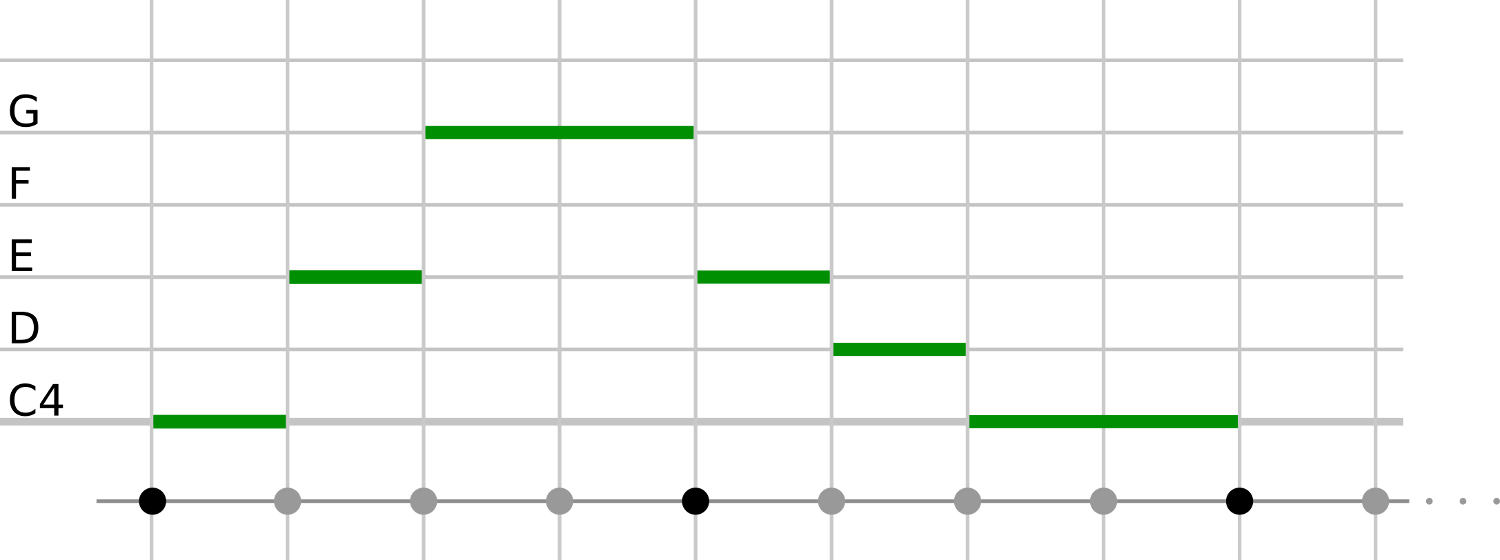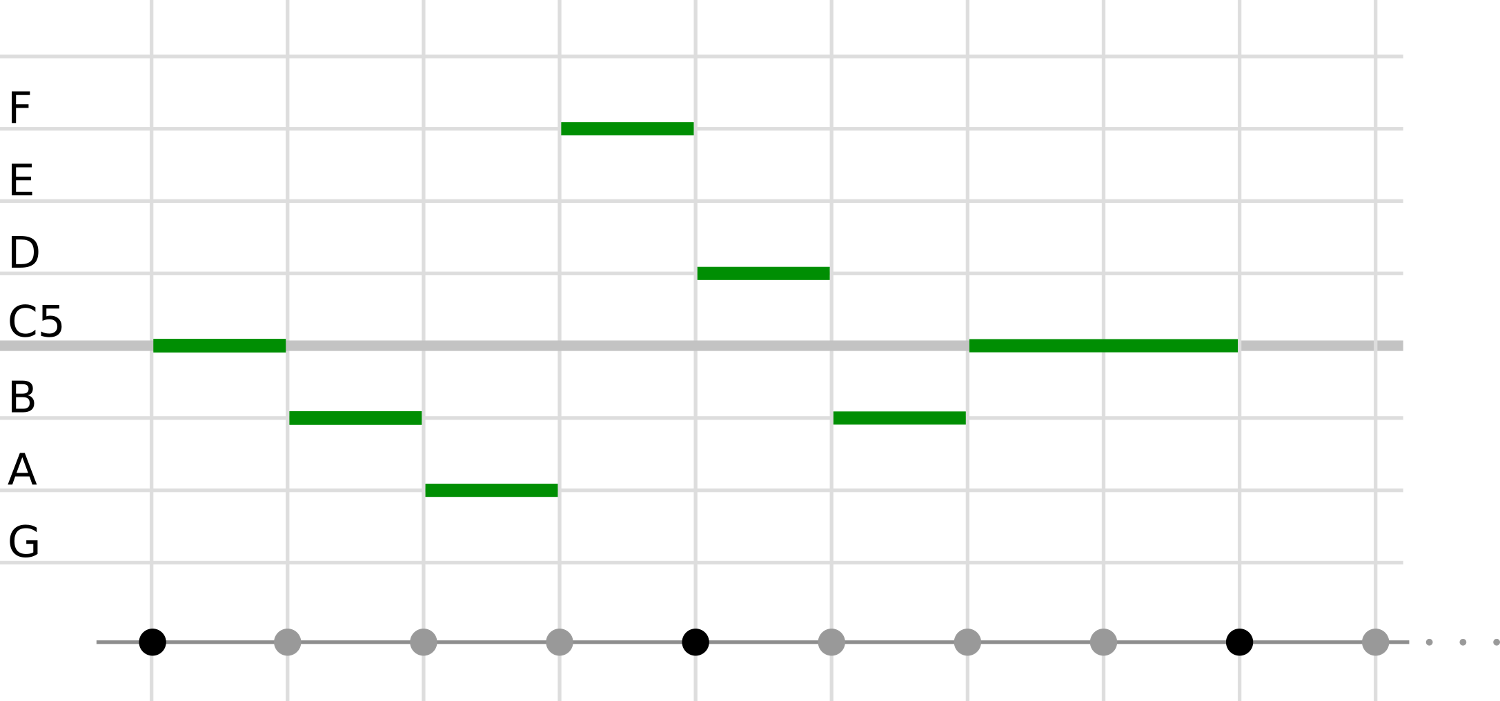The components of melody
Music is the art of arranging sound for expressive, creative and emotional reasons. It is very diverse, with countless genres and cultural traditions, although we will be sticking to western music as it is what the ocarina was designed to play.
If you imagine your favourite song in your head, you might notice certain layers to the sound, a singer taking the lead, and perhaps drums and a guitar in the background. In fact, most music can be broken down into a few basic components:
Percussion
Think of the 'boom, boom, boom' present in a lot of music. Percussion creates a steady repeating pulse in the background.
Harmony
Imagine the sound of a guitar being strummed. Harmony defines the tonal basis of a piece of music, which is overlaid by a singer or other instruments.
Melody
Hear a singer, or instruments like the flute or ocarina being played. Melody is usually the main focus of a piece of music, and what you would reproduce if you whistle a song.
The ocarina most often serves as a melody instrument. They can be played in harmony if multiple people play together, or by a single player playing a harmony ocarina, but lets ignore that for now.
The elements of a melody
Melodies are built from two distinct elements:
- Rhythm, when the notes are played in time,
- and pitch, which note to play on your instrument.
Rhythm
The easiest way to understand rhythm is to get up and go for a walk. As you are walking, notice how your feet meeting the ground form a consistent pattern? hit, hit, hit....
Now, imagine that you were to play a note every time your foot hits the ground, It would sound something like this:
If you listen to one of your favourite songs, can you hear this pulse? Can you also hear that the song is quite repetitive? Perhaps there is a chorus repeated multiple times throughout the song, and even the verses will remain remarkably similar.
Repetition is one of the things that makes music sound musical, and this is apparent even at the smallest scale. Beats are grouped together, and if you have ever heard someone counting, 1, 2, 3, 4, 1, 2, 3, 4 ... to a piece of music, they are counting this grouping.

These groups are the foundation on which the rhythm of a melody is made. The verses and choruses of a song usually contain a fixed number of these, like 8 groups in the verse, 8 groups in the chorus, etc.
The rhythms of a melody relate to this underlying pulse by varying the durations of the notes:
A note can be held, spanning the duration of two or more beats.
Alternately, the duration of a single beat can be divided, and multiple notes played in that time.
Melodies string together notes of different lengths, and the rhythm of a short melody might look something like this:
All of the other elements of music are built on these basic concepts of rhythm. Percussion is perhaps rhythm in it's purest form, but melody is also built on rhythms as you will see.
Pitch and notes
The other aspect of melody is pitch. Pitch describes the 'highness' or 'lowness' of a sound. High pitches sound like this:
And low pitches sound like this:
Pitched sounds are really common day to day, for example:
- Bird songs
- People singing or playing instruments like piano, flute or ocarina.
- A siren - usually sound alternating between two pitches.
Can you think of any others?
Timbre - same pitch, different 'colour'
In addition to pitch, notes also have a propriety called 'timbre', or 'tone colour'. Timbre is what makes an ocarina sound like an ocarina, a violin sound like a violin, and a piano sound like a piano. Sounds can have the same pitch, but have a different timbre.
You can hear the same pitch played on a collection of instruments with different timbres in the following audio sample:
Visualising pitch
It is easy to visualise the pitch of sounds using tools like a chromatic tuner, or a pitch graph like the one below.
In a pitch graph high pitches are drawn towards the top in the graph, and lower pitches are drawn towards the bottom.
Try whistling or singing, and watch how the line moves.
Discrete pitches and notes
Fundamentally, pitch is continuous. If you whistle in the above tool and make a 'whoop' sound, a smooth ascending curve will be drawn. But you may have noticed the fixed lines with names like 'F', 'G', or 'C#'.
To make it easier to make music sound musical, as well as to design instruments that people can more easily play, western music has standardised a number of fixed pitches out of this continuum that sound good together, which are called:
- C
- C sharp or D flat
- D
- D sharp or E flat
- E
- F
- F sharp or G flat
- G
- G sharp or A flat
- A
- A sharp or B flat
- B
These repeat multiple times in octaves, denoted by a number like 'C4' and 'C5'. The same note in a different octave sounds higher or lower in pitch, yet sound remarkably similar. This will be discussed in the future section Octaves and scale formation.
Any melody that you may want to play is formed by combining some collection of these notes in sequence. Standardising pitches allows us to play different instruments together. As a matter of fact, all western instruments play the same system of notes.
Scales
If you were to try making music from all of the notes mentioned above, it would sound very 'ghostly' and ungrounded. This 12 note scale is called the chromatic scale, and all of the notes are equally spaced. Moving from any chromatic note to any adjacent chromatic note will sound the same.
If you have a piano or keyboard you can hear this for yourself by playing adjacent notes, including the black keys.
Due to this, music is written using a selection of these notes called a 'diatonic scale'. Quite a lot of these scales exist, For example:
- The C major scale: C, D, E, F, G, A, B, C
- The C minor scale: C, D, Eb, F, Gb, Ab, B, C
- The C blues scale: C, D#, F, F#, G, A#, C
So... what is a melody?
A melody is just a collection of pitches, usually from one scale, which are played to a rhythm. If you visualised a simple melody in C Major using a pitch graph, it would look something like this:
Different scales have different tonalities. The major scale is often considered 'happy' sounding while the minor scale sounds 'sad'. Here is the same melody in both C major, and C minor:
Any melody that you may want to play is is just a collection of notes like this, and you can find out which notes using sheet music, or by ear. Real music then embellishes this with ornamentation.
Also note that the notes used in a melody are rarely random. They form structures called figures, phrases, and parts, which are essentially equivalent to words, sentences, and paragraphs. The movements within a melody also often relate to tonality and the tonic.
Tonality and the tonic
Most western music is tonal, which means that it is written to highlight a single pitch called the 'tonic'. The tonic is the root note of a given scale. For example the 'tonic' of both 'C major' and 'C minor' is 'C', even though the scales are formed from a different selection of notes.
Melodies can be thought of as a 'journey', moving through a selection of different pitches before finally returning to the tonic. It can be seen here, with the melody moving away from, and then back to the tonic of C.

Note that the tonic doesn't have to be at the bottom end of the range of notes used. Music may also be written to have the tonic in the middle. Sometimes this 'tonic in the middle' structure is called a 'plagal mode'.

Closing
Now that you know the fundamental elements of music, try listening to some music try to hear its separate elements:
- Identify the percussion, harmony and melody. Are all of them present?
- Try to hear and clap the rhythm of the melody.
